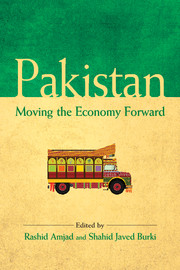Book contents
- Frontmatter
- Contents
- List of figures and tables
- Preface
- 1 Overview
- 2 Failed Economic Promise: Lessons from Pakistan's Development Experience
- 3 Economic Management Under IMF Tutelage: Key Lessons from the Musharraf and PPP Rule 1999–2013
- 4 A Country and an Economy in Transition
- 5 Tackling the Energy Crisis
- 6 Exports: Lessons from the Past and the Way Forward
- 7 The Future Path of Tax Reforms in Pakistan
- 8 Pakistan's Indus Basin Water Strategy: Past, Present and Future
- 9 Economic Governance and Institutional Reforms
- 10 Benefiting from Foreign Direct Investment
- 11 An Analysis of the Remittances Market in Pakistan
- 12 The Prospects for Indo-Pakistan Trade
- 13 Beyond the Poverty Line: A Multidimensional Analysis of Poverty in Pakistan
- 14 Can the New Intergovernmental Structure Work in Pakistan? Learning from China
- Contributors
- Index
12 - The Prospects for Indo-Pakistan Trade
Published online by Cambridge University Press: 05 May 2015
- Frontmatter
- Contents
- List of figures and tables
- Preface
- 1 Overview
- 2 Failed Economic Promise: Lessons from Pakistan's Development Experience
- 3 Economic Management Under IMF Tutelage: Key Lessons from the Musharraf and PPP Rule 1999–2013
- 4 A Country and an Economy in Transition
- 5 Tackling the Energy Crisis
- 6 Exports: Lessons from the Past and the Way Forward
- 7 The Future Path of Tax Reforms in Pakistan
- 8 Pakistan's Indus Basin Water Strategy: Past, Present and Future
- 9 Economic Governance and Institutional Reforms
- 10 Benefiting from Foreign Direct Investment
- 11 An Analysis of the Remittances Market in Pakistan
- 12 The Prospects for Indo-Pakistan Trade
- 13 Beyond the Poverty Line: A Multidimensional Analysis of Poverty in Pakistan
- 14 Can the New Intergovernmental Structure Work in Pakistan? Learning from China
- Contributors
- Index
Summary
Introduction
Trade between India and Pakistan has been fundamentally influenced by factors that are not purely economic. At the time of Partition in 1947, both economies were heavily interdependent, with the share of the Indian market in Pakistan's exports at close to one-fourth, and over half of Pakistan's imports coming from India. Thereafter, bilateral trade has had a chequered history. Trade virtually ceased after the wars of 1965 and 1971.
Some positive steps have been taken since 1995, when India announced its decision to grant most favored nation (MFN) status to Pakistan, and the latter established a positive list with respect to imports from India. The signing of the South Asian Free Trade Agreement (SAFTA) in 2004 was a major step forward in the eventual establishment of a customs union in the region. Recently, Pakistan announced its potentially landmark decision to grant MFN status to India by the end of 2012. In the interim period, a restricted positive list has transitioned to a negative list, which opens up a large percentage of tariff lines for imports from India. Further, the two countries have agreed to simplify customs procedures and facilitate the process of goods certification. India has also announced that it welcomes investment by resident Pakistanis and companies.
Clearly, the environment for bilateral trade has greatly improved. This augurs well for future growth in trade between the two countries, which are making an effort to move away from the old view of “peace first, trade later” to “trade now, peace later.” It is hoped that the expansion of trade will create stronger constituencies for peace in both countries.
The objective of this chapter is to explore the possibilities of Indo–Pakistan trade in the new environment. Section 1 describes the current level and pattern of bilateral trade. Section 2 identifies some basic issues in the context of trade development between the two countries.
- Type
- Chapter
- Information
- PakistanMoving the Economy Forward, pp. 311 - 331Publisher: Cambridge University PressPrint publication year: 2015
- 1
- Cited by



